
The International Seabed Authority (ISA) is a Kingston, Jamaica-based intergovernmental body of 167 member states and the European Union established under the 1982 UN Convention on the Law of the Sea (UNCLOS) and its 1994 Agreement on Implementation. The ISA's dual mission is to authorize and control development of mineral related operations in the international seabed considered the "common heritage of all mankind" and also protect the ecosystem of the seabed, ocean floor and subsoil in "The Area" beyond national jurisdiction. The ISA is to safeguard the international deep sea, the waters below 200 meters or 656 feet, where photosynthesis is hampered by inadequate light. Governing approximately half of the total area of the world's oceans, the ISA is to exercise oversight of activities that might threaten biological diversity and harm the marine environment. The Authority operates as an autonomous international organization with its own Assembly, Council and Secretariat.

Mining is the extraction of valuable geological materials and minerals from the surface of the Earth. Mining is required to obtain most materials that cannot be grown through agricultural processes, or feasibly created artificially in a laboratory or factory. Ores recovered by mining include metals, coal, oil shale, gemstones, limestone, chalk, dimension stone, rock salt, potash, gravel, and clay. The ore must be a rock or mineral that contains valuable constituent, can be extracted or mined and sold for profit. Mining in a wider sense includes extraction of any non-renewable resource such as petroleum, natural gas, or even water.

The United Nations Convention on the Law of the Sea (UNCLOS), also called the Law of the Sea Convention or the Law of the Sea Treaty, is an international agreement that establishes a legal framework for all marine and maritime activities. As of May 2023, 168 countries and the European Union are parties.

Polymetallic nodules, also called manganese nodules, are mineral concretions on the sea bottom formed of concentric layers of iron and manganese hydroxides around a core. As nodules can be found in vast quantities, and contain valuable metals, deposits have been identified as a potential economic interest. Depending on their composition and autorial choice, they may also be called ferromanganese nodules. Ferromanganese nodules are mineral concretions composed of silicates and insoluble iron and manganese oxides that form on the ocean seafloor and terrestrial soils. The formation mechanism involves a series of redox oscillations driven by both abiotic and biotic processes. As a byproduct of pedogenesis, the specific composition of a ferromanganese nodule depends on the composition of the surrounding soil. The formation mechanisms and composition of the nodules allow for couplings with biogeochemical cycles beyond iron and manganese. The high relative abundance of nickel, copper, manganese, and other rare metals in nodules has increased interest in their use as a mining resource.
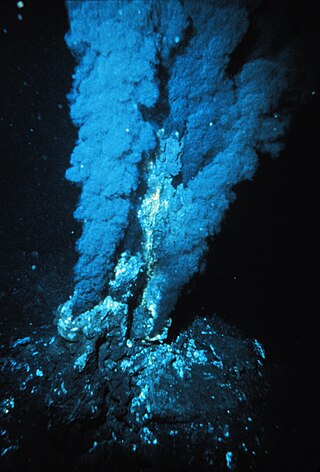
Hydrothermal vents are fissures on the seabed from which geothermally heated water discharges. They are commonly found near volcanically active places, areas where tectonic plates are moving apart at mid-ocean ridges, ocean basins, and hotspots. Hydrothermal deposits are rocks and mineral ore deposits formed by the action of hydrothermal vents.

An abyssal plain is an underwater plain on the deep ocean floor, usually found at depths between 3,000 and 6,000 metres. Lying generally between the foot of a continental rise and a mid-ocean ridge, abyssal plains cover more than 50% of the Earth's surface. They are among the flattest, smoothest, and least explored regions on Earth. Abyssal plains are key geologic elements of oceanic basins.
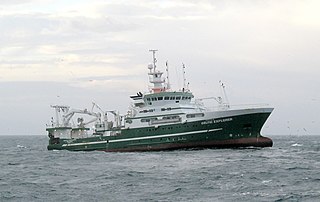
Bottom trawling is trawling along the seafloor. It is also referred to as "dragging". The scientific community divides bottom trawling into benthic trawling and demersal trawling. Benthic trawling is towing a net at the very bottom of the ocean and demersal trawling is towing a net just above the benthic zone. Bottom trawling can be contrasted with midwater trawling, where a net is towed higher in the water column. Midwater trawling catches pelagic fish such as anchovies and mackerel, whereas bottom trawling targets both bottom-living fish (groundfish) and semi-pelagic species such as cod, squid, shrimp, and rockfish.

The seabed is the bottom of the ocean. All floors of the ocean are known as 'seabeds'.
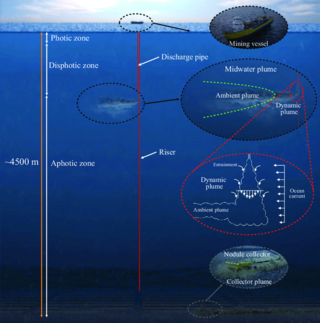
Deep sea mining is the extraction of minerals from the ocean floor at depths of 200 metres (660 ft) to 6,500 metres (21,300 ft).
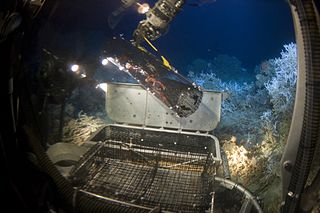
Deep-sea exploration is the investigation of physical, chemical, and biological conditions on the ocean waters and sea bed beyond the continental shelf, for scientific or commercial purposes. Deep-sea exploration is an aspect of underwater exploration and is considered a relatively recent human activity compared to the other areas of geophysical research, as the deeper depths of the sea have been investigated only during comparatively recent years. The ocean depths still remain a largely unexplored part of the Earth, and form a relatively undiscovered domain.
Nii Allotey Odunton, a mining engineer from Ghana, was the Secretary-General of the International Seabed Authority, serving back to back four-year terms starting in 2009 and ending in 2017. He was succeeded by Michael W. Lodge.

Environmental effects of mining can occur at local, regional, and global scales through direct and indirect mining practices. Mining can cause erosion, sinkholes, loss of biodiversity, or the contamination of soil, groundwater, and surface water by chemicals emitted from mining processes. These processes also affect the atmosphere through carbon emissions which contributes to climate change. Some mining methods may have such significant environmental and public health effects that mining companies in some countries are required to follow strict environmental and rehabilitation codes to ensure that the mined area returns to its original state.
Nautilus Minerals Inc. was a Canadian deep sea exploration and mining company founded in 1997, and listed on the Toronto Stock Exchange between 2007 and 2019. The company was known for Solwara-1, the first deep sea mining project, an attempt to explore and mine a mineral deposit on the seabed off the coast of Papua New Guinea. By 2019, the company had faced bankruptcy and was delisted due to long-standing environmental concerns about the project and financial turmoil, resulting in its assets being owned by Deep Sea Mining Finance Limited.

The Clarion-Clipperton Zone (CCZ) or Clarion-Clipperton Fracture Zone is an environmental management area of the Pacific Ocean, administered by the International Seabed Authority (ISA). It includes the Clarion Fracture Zone and the Clipperton Fracture Zone, geological submarine fracture zones. Clarion and Clipperton are two of the five major lineations of the northern Pacific floor, and were discovered by the Scripps Institution of Oceanography in 1954. The CCZ is regularly considered for deep-sea mining due to the abundant presence of manganese nodules.
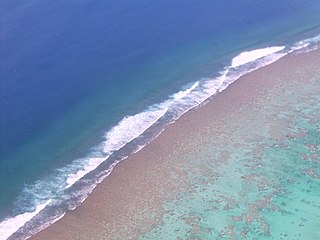
Marae Moana is a multiple-use marine protected area created on 13 July 2017, when the Parliament of the Cook Islands passed a bill creating the largest multiple-use marine protected area in the world at the time of its passage. Marae Moana covers the Cook Islands' entire exclusive economic zone of over 1.9 million square kilometers.
Deep Ocean mission is an Indian initiative to undertake the deep ocean exploration focused on India's exclusive economic zones and continental shelf. The program will consist of various crewed and uncrewed submersibles exploring the sea bed. One of the primary aims of the mission is to explore and extract polymetallic nodules, which are composed of minerals like manganese, nickel, cobalt, copper and iron hydroxide. The metals can be used in the manufacturing of electronic devices, smartphones, batteries and solar panels.

Debbie Anne Ngarewa-Packer is a New Zealand politician, iwi leader and activist. She is a Member of Parliament and co-leader of Te Pāti Māori alongside Rawiri Waititi, and is the chief executive of the Ngāti Ruanui iwi.
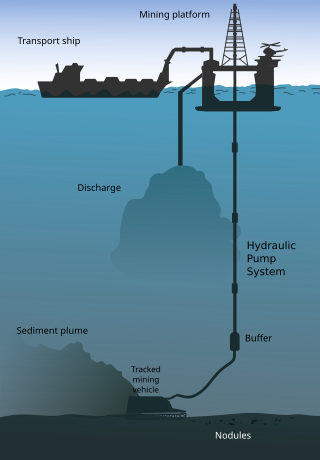
Seabed mining, also known as Seafloor mining is the recovery of minerals from the seabed by techniques of underwater mining. The concept includes mining at shallow depths on the continental shelf and deep-sea mining at greater depths associated with tectonic activity, hydrothermal vents and the abyssal plains. The increased requirement for minerals and metals used in the technology sector has led to a renewed interest in the mining of seabed mineral resources, including massive polymetallic sulfide deposits around hydrothermal vents, cobalt-rich crusts on the sides of seamounts and fields of manganese nodules on the abyssal plains. While the seabed provides a high concentration of valuable minerals, there is an unknown risk of ecological damage on marine species because of a lack of data.

Namibia is one of the first countries that issued mining licences regarding deep sea mining. studies that took place in 1970s discovered considerable amounts of phosphate deposits. The significance of seabed mining in Namibia's blue economy is highlighted by the country's status as a "phosphate factory". This is due to the exceptional upwellings of the Benguela Current ecosystem, a transboundary ocean current that spans from South Africa in the south to Angola in the north, passing through Namibia. Those deposits were found in depths between 180 and 300 meters below the sea level. In 2011 the Namibian government issued licences regarding the exploitation of the seabed phosphate resources after the necessary Environmental Impact Assessments (EIAs). The action plan that stood out was that of Namibian Marine Phosphates (NMP), a joint venture formed in 2008 between two Australian-based companies, Minemakers and Union Resources and Namibian-based Tungeni Investments. The so-called Sandpiper phosphate mining project outlay was introduced in January 2012 along with environmental reports regarding the effect this operation would have on marine life as well as the fishing industry and water quality changes. Those phosphorite resources are being found in continental shelves and slopes in America, Northern Spain, Morocco, Namibia, and South Africa which show a high potential for exploration.
On 25 June 2021, the president of Nauru, Lionel Aingimea, made a formal request to the president of the International Seabed Authority's (ISA) council to complete the adoption of rules, regulations and procedures necessary to facilitate the approval of plans of work for exploitation of deep-sea resources in the Area. This request is based on the "2-year rule", which is part of a provision from the 1994 Agreement relating to the Implementation of Part XI of the United Nations Convention on the Law of the Sea. The provision can be found in section 1 of the annex, and it states that the ISA must complete the adoption of rules, regulations and procedures for the approval of the exploitation of deep-sea minerals within 2 years of the request. The ISA's current deadline for drafting new regulation is set in July 2023, although some claim that this is not a "hard" or "fixed" deadline. Due to the issue's complexity, negotiations have thus far failed to come to a concrete agreement. Even if it fails to set clear standards for deep-sea mining activities, the ISA must consider applications for exploitation in waters outside national jurisdictions and provisionally approve contracts after July 2023. Many experts fear that deep-sea mining activities that are not adequately regulated could significantly impact the marine environment, the economies of many nations and the livelihoods of indigenous groups who depend on the oceans for survival.
















